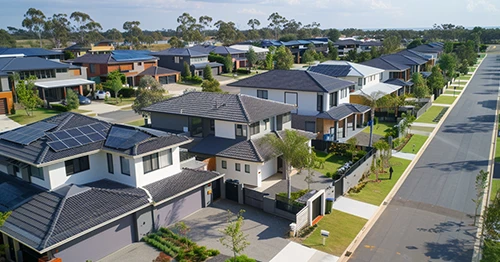Updated: 03 Apr, 2025
In March 2025, Australian housing values rose 0.4%, marking the second consecutive month of gains and reversing a short-lived downturn that spanned the final quarter of 2024. According to CoreLogic’s Home Value Index (HVI), national dwelling values have now climbed to new record highs, buoyed by a February interest rate cut, improved consumer sentiment, and stabilising economic indicators. The recovery was broad-based, with every capital city except Hobart recording a rise, and regional markets continuing their strong performance.
State Performance Overview
| State/City | HVI Change (%) | Description |
|---|---|---|
| Sydney | +0.3% | Sydney’s values have risen for two consecutive months, now sitting just -1.4% below their peak. |
| Melbourne | +0.5% | Melbourne is showing early signs of recovery, rising 0.9% across the past two months. However, values remain -5.6% below the March 2022 peak. |
| Brisbane | +0.4% | Brisbane continues to show steady growth, supported by strong affordability and demand. Values are now at record highs. |
| Adelaide | +0.8% | One of the strongest performers nationally, Adelaide values are also at new peaks, driven by robust demand and limited supply. |
| Perth | +0.2% | Growth has slowed, and values remain slightly below their October 2024 peak. Perth leads five-year growth with a 75.4% increase since 2020. |
| Hobart | -0.4% | The only capital to post a decline, Hobart’s market remains subdued amid reduced demand and investor pullback. |
| Darwin | +1.0% | Darwin topped monthly growth among capitals, but longer-term performance remains modest. |
| Canberra | +0.2% | Canberra’s market is flatlining, with values down from peak levels. |
Regional Markets vs. Capital Cities
Regional housing markets maintained their edge over capital cities in March, with the combined regional index rising 0.5%, slightly ahead of the 0.4% lift recorded across the capitals. However, growth momentum appears to be converging, as city markets begin to accelerate while regional trends hold steady.
On an annual basis, regional Western Australia and Queensland stood out as the top performers. The Mid-West region of WA led the nation with an impressive 25.4% growth in dwelling values, followed closely by Townsville in Queensland, up 23.5%. Other regional hotspots included Gladstone (+22.2%), Central Highlands (+21.8%), and Mackay (+20.2%), all reflecting strong demand in affordable, lifestyle-oriented markets where supply remains tight.
Rental Market Overview
Rents continued rising in March, with the national rental index up 0.6%, mirroring February’s increase but well below the 1.0% rate seen a year earlier. The annual rental growth slowed to 3.8%, the weakest since March 2021. Despite this, rents have surged 38.4% over the past five years, far outpacing wage growth.
Capital cities saw mixed results, with Hobart leading (+1.2%) and Melbourne lagging (+0.3%). Unit rents continue to rise faster than house rents in most capitals, reflecting demographic shifts and affordability pressures.
Gross rental yields rose modestly, reaching 3.53% in capital cities and 4.42% in regional areas, the highest since 2019. However, high mortgage rates and rising maintenance costs continue to compress real investor returns.
Market Activity And Selling Conditions
Listing activity remains subdued, with total stock levels still low relative to historical averages. While some cities saw increased vendor listings, particularly Perth and Adelaide, supply remains tight in many areas. Auction clearance rates improved marginally, reflecting increased buyer confidence, but remained patchy in high-priced and supply-heavy markets like Sydney and Melbourne.
Vendor discounting and longer days on market indicate buyers still have the upper hand in many areas, though improved sentiment may begin to tilt the balance.
Market Forecast
The rate cut in February likely drove a short-term boost to borrowing capacity and sentiment, but structural affordability issues remain.
- Affordability Constraints: Mortgage repayments continue to consume over 50% of median household income, near record highs.
- Interest Rates: Even with a bullish forecast of 75 basis points in cuts by year-end, the cash rate would remain above neutral, limiting stimulatory effect.
- Sentiment Recovery: Consumer sentiment is rising, aided by easing inflation and cost-of-living relief. This could support transaction volumes, but not necessarily prices.
- Housing Supply: Supply remains tight due to high construction costs and labour shortages. This could place upward pressure on prices despite soft demand.
- Population Growth Normalisation: Migration has slowed, bringing housing demand back to pre-COVID levels.
Overall, the outlook remains cautiously optimistic. Momentum is returning, but affordability barriers and a cautious lending environment suggest a sustained upswing may remain elusive.





